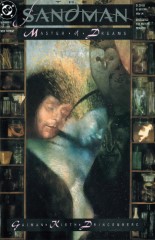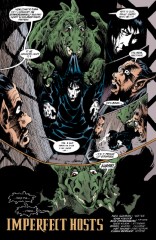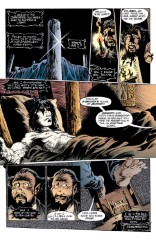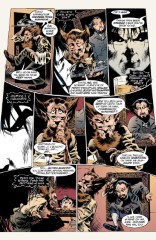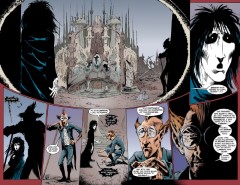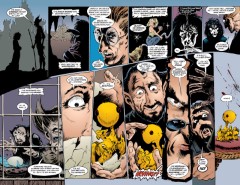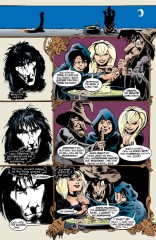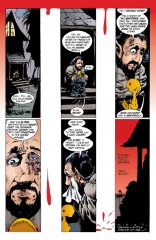Issue 2: "Imperfect Hosts"
Neil Gaiman, Sam Kieth, and Mike Dringenberg
- Second part of first storyline, More than Rubies
- Second story reprinted in Preludes and Nocturnes
- Audible Act I Chapter 2
- Netflix Episode 2
Page 1#
The black-haired man is Abel, the other Cain. These would be familiar to most long-term readers of comics. Originally, they were the hosts for DC's watered-down versions of EC's mystery series. Cain was the host of House of Mystery, Abel the host of House of Secrets. Cain and Abel also appeared in Plop!, a DC humor title of the 1970s, along with Eve; they were drawn there by Sergio Aragones, who has appeared in Mad and currently does Groo the Wanderer, which is why Sergio did the pinup of them in Sandman Special #1.
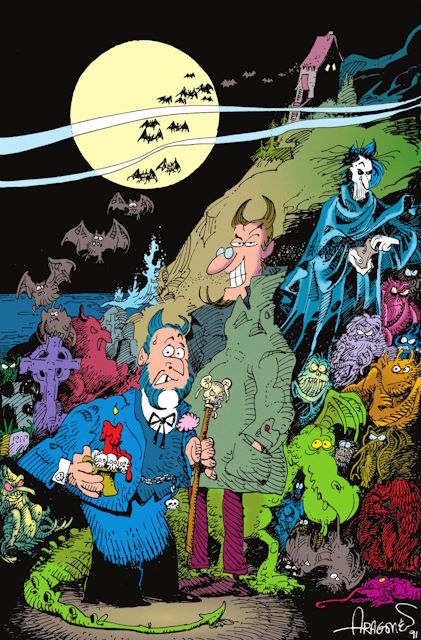
Cain and Abel, of course, are the first two children of the first two people in Genesis, the biblical creation story. Cain slew Abel over a disagreement over their offerings to God, was marked by God, and was sent to live in the Land of Nod. The nursery rhyme of "Winken, Blinken, and Nod" identifies the Land of Nod as the Land of Dreams.
In Swamp Thing #33 (I believe), Alan Moore identified them as living in humanity's subconscious when Abigail Arcane Cable visited them in a dream and learned more about Swamp Thing's origins. Under Moore's terminology, a mystery may be shared, but a secret must be forgotten if one tries to tell it. Since the issue is mostly a reprint of the first Swamp Thing appearance from HoS #92, Abby chooses to hear a secret rather than a mystery. She wakes up, tries to talk about the dream, and forgets it. Since then, Cain and Abel have been wandering around the fringes of DC's mystic titles (and a rather silly version of Cain appeared in Blue Devil). It has been established that Cain kills Abel rather often, but Abel always gets better. They, and many other characters in this issue, appear because of their roles as "mystery title hosts"; this issue is Gaiman's homage to the predecessors to DC horror line of today.
Page 2#
Panel 3
This is Gregory, a gargoyle, albeit a rather draconian one. He was a resident of the House of Mystery with Cain during the long run of this rather mediocre mystery title. He also appeared in Plop! Gregory pops up now and then with Cain and Abel as supporting cast members in Sandman.
Page 3#
Panel 4
Morpheus is here referred to as the Prince of Stories.
In Leslie Klinger's annotations, it's noted that "The Prince of Stories" appears in "I'm set free" by the Velvet Underground. Neil Gaiman mentions this song as somewhat of an inspiration on his blog and says the song "seems to have the whole plot of Sandman in it."
Page 4#
Panel 3
Abel identifies himself as the victim from "the first story."
Cain is distinguished for being the first murderer, and Abel for being the first victim. One of the themes of Sandman is the equation of dreams and stories, or perhaps the use of dreams as a vehicle for stories. Gaiman is first and foremost a storyteller, as opposed to Alan Moore, for example, who is primarily concerned with saying something in his writing and only secondarily concerned with the story.
Panel 4
The Shifting Zones is a reference I do not recognize. The boundaries between the real world, the various afterlives, and such places as the realm of dreams are indistinct and variable (see the Realm of the Just Dead in Swamp Thing Annual #2, reprinted in the tpb Love and Death). This may be the simplest explanation of what the Shifting Zones are.
Page 5#
Panel 1
"It was a dark and stormy nightmare" is a pun. "It was a dark and stormy night" is a cliched way of beginning a story, most often seen in the comic strip Peanuts, and a nightmare is a dream, of course.
In addition to beginning Madeleine L'Engle's A Wrinkle in Time, the line "It was a dark and stormy night" was used by the 19th century author Bulwer-Lytton. San Jose State University's English Department sponsors a contest each year in which entrants submit their proposed worst opening line for a novel. The results have been collected into three works, It Was a Dark and Stormy Night, Son of It Was a Dark and Stormy Night, and Bride of It Was a Dark and Stormy Night, all edited by Scott Rice and published by Penguin.
Closer to home, Detective Comics #500 features an adaptation of Snoopy's version of "It Was a Dark and Stormy Night" by Walt Simonson, starring Batman, with no dialogue. The captions read, in part, "It was a dark and stormy night. A shot rang out. The maid screamed. Suddenly, a pirate ship appeared on the horizon." This book is well worth seeking out, for this story, and for other well done stories.
Panel 3-4, 6
The Dreamtime is one name of Morpheus' realm, more commonly named later as The Dreaming (see note on page 10). It is also the name of an astral-space-like realm in Australian aboriginal myth. "Dreamscape" is the name of a moderately good film from the early 80s with Dennis Quaid, as well as being the obvious choice for a word that means "the landscape of the dream realm." The Gates of Horn and Ivory are evidently the entry points to Morpheus' stronghold in the Dreamtime. True dreams exit through the Gate of Horn, and false dreams through the Gate of Ivory. This conceit dates back at least to Greek and Roman mythology:
Dreams surely are difficult, confusing, and not everything in them is brought to pass for mankind. For fleeting dreams have two gates: one is fashioned of horn and one of ivory. Those which pass through the one of sawn ivory are deceptive, bringing tidings which come to nought, but those which issue from the one of polished bone bring true results when a mortal sees them.
-- Homer, Iliad XIX p560There are two gates of sleep. One is of horn, easy passage for the shades of truth; the other, of gleaming white ivory, permits false dreams to ascend to the upper air.
-- Virgil, Eclogues VI p893The gates may originate in a misunderstanding of Greek, or in a Greek pun. In Greek (transliterated to the Roman alphabet), ivory = elephas but elephairo = to deceive. Horn = karas; karanoo = to achieve.
The Gates may also appear in the "Dreamlands" stories of H.P.Lovecraft and Brian Lumley.
Page 6#
Panel 2
Penny Dreadfuls are a British term for dime novels, cheap, sensational novels of crime, adventure or suspense.
Panel 6
The Letters of Commission are evidently new. Note that Abel is emerging from his own picture.
Page 8#
Panel 1
Arkham Asylum is an institution in the DC universe. Most of Batman's villains, for example, are imprisoned there. It was the subject of a graphic novel by Grant Morrison and Dave McKean. The name arises from the work of HP Lovecraft, an early horror writer, who used the fictional Arkham, Massachusetts as a setting for many of his tales. Following his death, an Arkham Press was founded in his honor, primarily for the purpose of keeping his stories in print. Arkham was also used as the name of a town in some 1960s appearances of the Spectre.
Panel 3-4
Ethel Dee was born Ethel Cripps, whom we saw in issue #1.
The letter balloon between panel 3 and panel 4 is incorrectly drawn. The first part is correctly identified as being said by the Asylum administrator, Doctor Huntoon. The second part is actually said by Ethel Dee.
Dr. Huntoon has appeared before, in a Rick Veitch issue of Swamp Thing. He has the nickname "Piggy." Dr. Destiny (whose name may or may not have been given before as John Dee) has fought the Justice League of America on the order of ten times. He originally appeared as a normal human being who had invented anti-gravity (this from JLA #5, "When Gravity Went Wild"). Subsequently, he invented a "materioptikon", which turned dreams into reality. Later, he invented a ruby materioptikon, and a dream materioptikon. At that point, it became necessary to remove his power to dream, which caused him to waste away to a human skeleton.
It has been suggested that John Dee is the son of either Roderick Burgess or Ruthven Sykes.
Although Dee's coloration, which is not consistent with earlier appearances, suggests that he might have non-Caucasian blood, this is not consistent with his surname, which is the same as what is presumably his mother's married name. There may be some relationship with the historical Dr. John Dee, the court astrologer of Queen Elizabeth I and the inventor/discoverer of the Enochian Keys (no clue what they are, though).
Page 10#
Panel 2
Here, the comic reads "Shouldn't we have told him? About the Castle? About what's happened to the Dreamtime?" but the line in the Audible version is "...what's happened to The Dreaming". This indicates that at some point Gaiman changed his mind over the canonical name of Dream's domain.
Page 12-13#
Panel 2-3
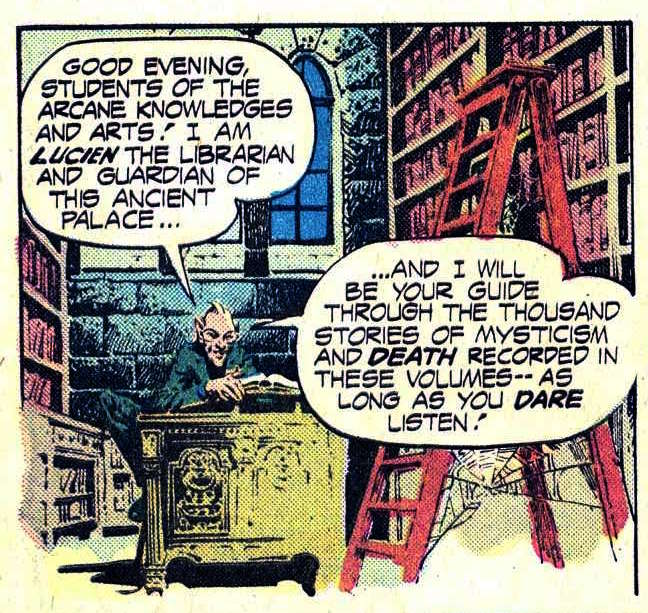
This is a double page spread. Lucien, who henceforth often appears in the role of major domo to Morpheus, was the host of a comic called Tales of Ghost Castle which ran for three issues in 1975. Lucien was the guardian and librarian of an abandoned castle, in Transylvania, which fits closely with his role in Sandman. "Lucien" is the French equivalent of "Lucian." The name may derive from the Latin word for "light", or may be related to Lucian (A.D. 118-170), a Greek rhetorician and satirist, or to "Lucian the Martyr," (A.D. 240-312), a theologian and Biblical critic.
Panel 7
Lucien's library will appear again later.
Page 14-15#
Panel 2
In this double page spread, the Raven Woman is probably the same as Eve, who appears later in the series, and, as mentioned above, was linked to Cain and Abel both biblically and in Plop!.
Panel 3
Brute and Glob were servants of the 70s Sandman, a Dr. Garrett who dwelled in dreams, rescued a boy named Jed an awful lot, and died an almost unnoticed death. He was replaced by Hector Hall in the 1980s, a dead member of Infinity Inc. (The Silver Scarab), the son of the Golden Age Hawkman and Hawkgirl, and the lover and husband of Lyta Trevor, the second generation Fury. This will become relevant later.
Panel 4
The Fashion Thing is just another inhabitant of Dreamtime, by all indications. She is referred to later.
Panel 7
By "do it to you", Cain presumably means his habit of killing Abel, as opposed to any sexual interpretation based on the slang meaning of "doing it".
Panel 11
The restriction on gargoyle names may be an unspoken rule from the mystery books.
Page 16#
Who's Who #15 (1991) has a great deal of information on the Three Witches, or the Three-in-One as they are called here. The Three may appear as a single entity, or as a group of three women. The three women invariably appear symbolically as maiden, mother, and crone.
In the Egypt of the Pharaohs, the Three were known collectively as Mut, and named individually as Maat, Hathor, and Nekhbet. In Egypt, as in many of their incarnations, the Three represented matriarchal, pre-civilization, mother/goddess worship.
In Greek mythology, the Three were known as the Fates, or Moirae, named Clotho, Lachesis, and Atropos. Each man's life was a thread spun by Clotho, measured by Lachesis, and cut by Atropos. The Fates were the sisters of Hypnos (god of sleep), Oneiros (god of dreams), and Thanatos (god of death). These deities were the parthenogenetic children of Nyx (night), who was herself born of no mother to Chaos.
They have also been identified with the Furies, although this incarnation is generally referred to as "the Kindly Ones" to avoid their wrath. In the original Greek, the Furies are known as Erinyes, while the Kindly Ones are Eumenides. The Furies are named Tisiphone, Megaera, and Alecto. The Three are also identified with a mother goddess form of Hecate Trioditus ("of the three ways"). In this form, Luna ruled heaven, Artemis or Cynthia ruled Earth, and Hecate ruled the underworld. Hecate is more familiar to modern Westerners as a goddess of witches and black magic.
The Romans knew the Three as the Parcae or Fortuna. Again, the pre-civilization goddess-worshippers followed the Three, as Juventas the maiden, Juno the mother, and Minerva the wise old crone. The Norse knew the Three as the Norns, Urth, Verthandi, and Skuld. "Skald" is also the Viking word for poet.
The Norse were (and are) an Indo-Germanic people, so basically the same archetypes will be found in Norse as well as Greek myths.
The three Norns are named after the past, present and future (in that order). In modern Norwegian you will find remnants of Verdande in the word "Vaerende" roughly translated "the existing" (which covers at least one of the aspects of the word). As for the future, which Skuld represents, it is represented by the verb "skuld", which means to become, should be and/or could be. If we look at the english word "should" we'll find that it has evolved from the same root as "skuld", also the Norwegian word "skulle" (with basically the same meaning as "should") shares some qualities with "skuld" source: Caplex (a Norwegian dictionary and my own basic knowledge in etymology and the history of languages).
The Three occupied a position in Anglo-Saxon lore as the Weird Sisters, and Shakespeare used this cultural referent in his play Macbeth.
Irish Celtic myth portrayed the Three as the Morrigan, a triune war goddess whose aspects were named Nemhan, Babd, and Macha. The Morrigan is also identified with Morgan le Fay, of the Arthurian cycle of legends.
Page 18#
Panel 1
The Witching Hour was another DC mystery title hosted by the three ladies pictured in panel 3. The identification of them with the triune goddess is new to Gaiman.
Panel 3
"Hecateae" is probably the correct Greek plural for "Hecate", although this appears to be an unusual way of referring to that form of the Three.
Page 19-20#
- Notice that the ladies are changing position, or into one another's shape, cyclically, and that what one eats, the next finishes.
Page 19#
Panel 5
Diana, Mary, and Florence are the Supremes, a three woman vocal group from the 1960s. Diana (Ross) went on to a solo career.
Panel 6
The three Graces are another set of Greek deities. Their name may also be translated as Charities. Individually, they are Aglaia (variantly Pasithea or Charis), Euphrosyne, and Thalia. (Variant spellings exist depending on the source and the method of transliteration from the Greek alphabet.)
Panel 7
In The Witching Hour, the three ladies are indeed named as given. Mordred is from Arthurian legends, Arthur's bastard son by his half-sister Morgaine (many possible spellings), thus the reference to its inappropriateness.
Page 20#
Panel 3
In regards to the conflict between The Fates and Circé, Klinger says that in the DC Universe, Circe is interpreted as the daughter of Hecate, who eventually battles with Hecate's version of Diana/Wonder Woman.
I'll specify that a bit because I think Klinger's wording is misleading here and not very clear: At one point, Hecate divided her essence/power into five humans/beings. These humans usually didn't know of it, and when they died, it was passed on to the next person until Hecate had need for it. And two of these were Circe (she was given the witchmark by Hecate in person early on) and Diana/Wonder Woman (one of the other ones was Black Orchid). The arc is long-winded and probably too much to go into here, but the bottom line is that Diana had 4/5 of power within herself at some point (you would need to read Witching Hour) and was under Hecate's control. Circe then set the Justice League Dark on her heels to kill her. Diana managed to do that herself though because she regained control of her body and killed Hecate (quite gruesome really 😂). And then Circe sneakily absorbed all the remaining powers and became the new goddess of magic.
So that's why there's bad blood I guess. Not between Morpheus and all incarnations of the Three (well…), but the Hecateae specifically. How and where he should have helped—who knows, but god(esses) are born and die in the Dreaming, so to speak, so it would probably always be possible to find a connection that way. It was probably just to tie everything that was happening in the wider DC Universe at the time together.
Page 21#
Note that the Fates give exactly one answer apiece, and it is deliberately incomplete.
Panel 1
John Constantine originally appeared in Swamp Thing #37, and is the main character in Hellblazer. He is a minor magician, a "jumped-up street thug". His tarot card is always "The Hanged Man" or "The Fool." He is of a long line of Constantines who live dirty lives of betrayal and death. He, as well as Morpheus and most of DC's mystic characters, may be seen in the Books of Magic, a four issue Prestige Format series written by Gaiman.
Panel 2
This is, of course, Ruthven Sykes from issue 1.
Panel 3
The mother is Ethel Cripps Dee, the son is John (Dr. Destiny) Dee, the superhumans are the Justice League of America. "Weird" as in "weird sisters" is a old word meaning "fate."
Page 23#
Panel 2
Goldie is named after an imaginary friend to whom Abel told his original stories in House of Secrets.
Credits
- Originally collated and edited by Greg Morrow.
- Tom Galloway tyg@dip.eecs.umich.edu
- Maurice Beyke beykema@infonode.ingr.com
- Marcus Brazil matmnb@lure.latrobe.edu.au
- Paul N Watts watts@csa2.lbl.gov
- Thomas White twhite@mozart.amd.com
- Viktor Haag vehaag@crocus.waterloo.edu
- Alexander Scott Kay akay@isis.cs.du.edu
- Connie Hirsch fuzzy@athena.mit.edu (Pinkdex - TNG)
- Col. Sicherman gls@windmill.ATT.COM
- denni c hwang hwa5@midway.uchicago.edu
- Dan Holzman holzman@fnal.fnal.gov
- jasona@sco.COM ( too big to be a gremlin )
- Tanaqui C. Weaver cen@vax.oxford.ac.uk
- Much of the information on the Three Witches is liberally plagiarized from Alisa Kwitney's writing in Who's Who #15 (1991).
- Ralf Hildebrandt added lots more details and made some edits.
- Richard Munn added some image references, noted the "Dreamtime/Dreaming" differences, and added the additional reference to the Gates of Horn and Ivory on p 21.
- /u/Mysterious-Fun-1630 noted the Velvet Underground connection and the conflict with Circe were both mentioned in Leslie Klinger's annotations.
Last modified by Richard Munn on 2023-08-21 - Fixed some formatting, and improved blockstyle plugin behaviour
[edit this page] [page history]
